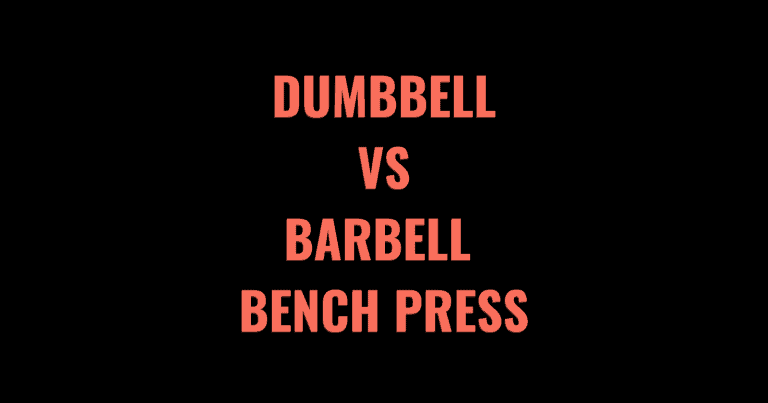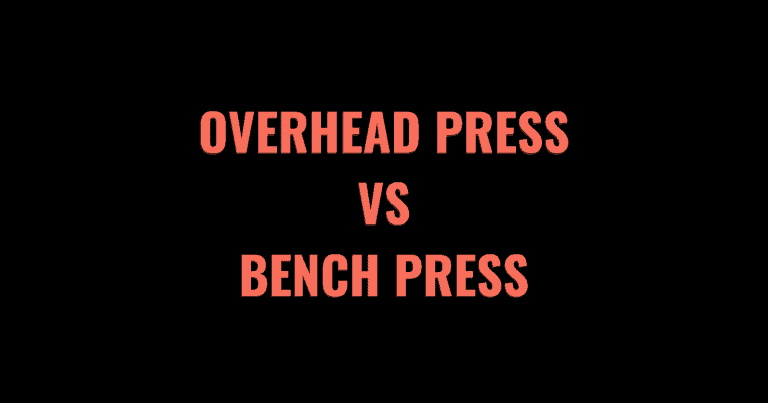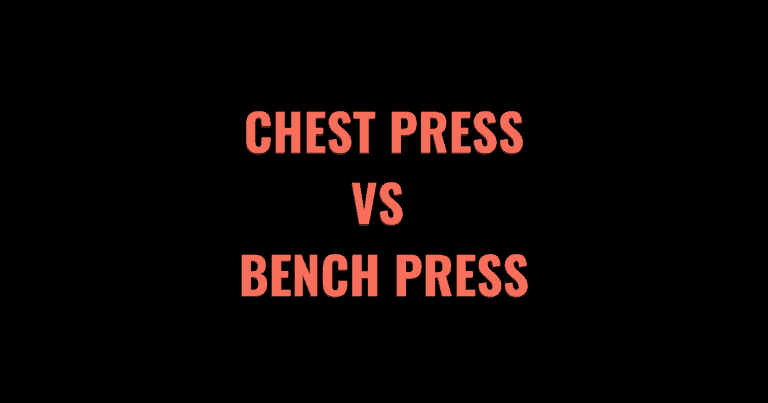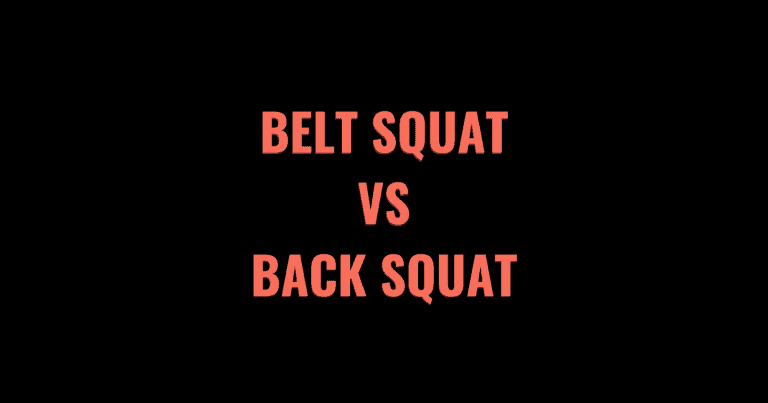Learning to do a deadlift with proper technique is a rite of passage for any serious lifter. Deadlifts are a staple exercise for improving your full body strength, and they carry over well to other exercises like the clean and snatch and the barbell row. The traditional deadlift is performed with a standard barbell.
Some lifters replace the deadlift with a variation known as the trap bar deadlift. Below, we’ll go over both the barbell and the trap bar deadlift, the pros and cons of each, and help you determine if one is better than the other for reaching your strength and hypertrophy goals.
Table of Contents
- 1 Trap Bar Deadlift vs. Barbell Deadlift
- 2 Pros and Cons of Each Movement
- 3 When to do an exercise
- 4 Trap Bar Deadlift vs. Barbell Deadlift – Muscles Used
- 5 Form Differences
- 6 Helpful Form Cues
- 7 Common Form Mistakes
- 8 Frequently Asked Questions
- 9 Other Exercise Comparison Posts
- 9.1 Floor Press vs. Bench Press: Pros, Cons, and Differences
- 9.2 Dumbbell vs Barbell Bench Press: Differences and Pros & Cons
- 9.3 Preacher Curl vs Bicep Curl: Differences, Pros, and Cons
- 9.4 Overhead Press vs. Bench Press: Pros, Cons, & Differences
- 9.5 Barbell Curl vs Dumbbell Curl: Benefits & Differences
- 9.6 Bench Press vs Chest Press: Pros and Cons
- 9.7 Dips vs Bench Press: Pros & Cons
- 9.8 Rack Pulls vs. Deadlifts: Differences, Pros, and Cons
- 9.9 Belt Squat vs. Back Squat: Pros & Cons
- 9.10 Romanian Deadlift vs Deadlift: Which is Better?
- 9.11 Flat vs. Incline Bench Press: Which is Better?
- 9.12 Preacher Curl vs Concentration Curl: Which is Better?
Trap Bar Deadlift vs. Barbell Deadlift
What is the main difference between a trap bar deadlift and a barbell deadlift?
The location of the loaded weight about your body is the main difference between these types of deadlifts. In a standard barbell deadlift, you reach forward and hold the weight in front of you. On the other hand, a trap bar deadlift requires you to stand inside the hexagon of the trap bar and hold onto handles by your sides.
The trap bar deadlift is a variation of the standard barbell deadlift, which uses a special type of barbell known as the trap bar or the hex bar.
The trap bar deadlift is typically easier on the spine than the traditional deadlift and engages more of the quadriceps. The standard deadlift is slightly more effective at recruiting the posterior chain muscles. Most lifters can deadlift comparable weights in a trap bar deadlift and a standard barbell deadlift, so the best exercise for you will come down to personal preference.
Pros and Cons of Each Movement
The choice between a trap bar deadlift and a barbell deadlift remains hotly contested among fitness enthusiasts. Some praise the trap bar for its ability to load heavier weights while alleviating pressure on the spine. Others are critical of the variation, believing that it resembles a hybrid between a deadlift and a squat and is ineffective at loading the posterior chain. We’ll go over the major pros and cons of each exercise here, though the best exercise for you will depend on individual factors.
Trap Bar Deadlift Benefits
Here are some of the advantages of trap bar deadlifts.
Easier on the lower back
The trap bar deadlift was created by Powerlifter Al Gerard, whose back pain prevented him from performing the conventional deadlift. The trap bar places the weight on either side of your legs rather than in front of them. Changing the location of the weight reduces the forward tilt of the torso and eases the pressure on the lumbar spine.
More natural wrist position
Standard barbell deadlifts are usually done with a pronated (overhand) grip, but lifters often use a mixed grip to stop the barbell from rolling out of their hands. Orienting the palms inward is more comfortable and stable, reducing the risk of losing your grip or straining your biceps before your legs have achieved maximal stimulus.
Less technically demanding
Conventional deadlifts may look simple but are quite technically complex and difficult to master. Trap bar deadlifts are slightly easier to perform, making them more beginner-friendly.
Fewer scrapes on your shins
Keeping the barbell close is important for a safe conventional deadlift, but it can graze your shins if you aren’t wearing long pants or high socks. Trap bars allow you to keep the weight close to the center of your body without scratching and bruising your legs.
Trap Bar Deadlift Drawbacks
Here are some of the drawbacks of trap bar deadlifts.
Less posterior chain engagement
The trap bar deadlift engages the hamstrings to a lesser degree than a conventional deadlift. If you are mainly doing trap bar deadlifts, you may want to consider adding accessory exercises to fire up the backs of your legs, such as a dumbbell Romanian deadlift.
Not specific to Powerlifting
If you are a Powerlifter, you must get comfortable deadlifting a standard barbell. While you can still include the trap bar in your programming, you should prioritize your traditional barbell deadlift technique to perform the best in your sport.
You need a trap bar
This may sound obvious, but if you don’t have regular access to a trap bar, it will be difficult to do trap bar deadlifts often enough to make significant progress or gains with this exercise.
May not suit your biomechanics
The trap bar has a standardized height for the handles. Its construction can limit how wide your stance can be. The trap bar deadlift may be less comfortable for people who are very short and can’t reach the handles, or very tall and cannot achieve the proper stance without interference from the handles. The bar also limits your options for variations like the sumo deadlift.
Barbell Deadlift Benefits
Here are some of the benefits of barbell deadlifts.
Specific to Powerlifting
The conventional deadlift is an essential competition lift for Powerlifters. Getting used to a standard barbell for this lift will give you an advantage on competition day.
Builds a stronger back
Barbell deadlifts are not only a great lower body exercise, but they also add size and strength to your lower and upper back. As they are a versatile and effective full-body exercise, bodybuilders often include deadlifts in their upper body days.
Gives every muscle in your body a workout
The conventional deadlift works almost every muscle in your body when done correctly. This makes them highly efficient and a great choice when you only have time for a few lifts.
Better engagement of the hamstrings
The anterior loading with a conventional barbell has a slight advantage over the trap bar deadlift for activating your hamstrings and posterior chain.
Accessible and versatile
Barbell deadlifts only require a standard barbell and plates. This setup is more convenient than purchasing a new piece of equipment, as it can also be used for many other exercises.
Barbell Deadlift Drawbacks:
Here are some of the drawbacks of barbell deadlifts.
More strain on the lower back
The trap bar deadlift was created because of the pain the standard barbell deadlift can cause. You need excellent hamstring mobility and a strong core to do a conventional deadlift safely. Tall lifters may be more prone to hurting their back in a conventional deadlift as it is more difficult to maintain an upright torso.
More technically demanding
Barbell deadlifts require a meticulous technique to get the most benefits and avoid injury. People without a solid understanding of weightlifting technique should always seek advice from a qualified personal trainer before attempting heavy deadlifts.
Less engagement of the quadriceps
While great at loading your posterior chain, the conventional deadlift won’t fire up your quads as much as the trap bar deadlift.
Longer recovery periods needed
Due to its full body nature, the barbell deadlift can require a longer recovery period between sets and sessions. Muscles are built at rest, not when being torn, so make sure you have scheduled adequate rest in between deadlifting sessions to avoid overexerting your muscles.
When to do an exercise
When to do a trap bar deadlift
If you have a history of back injuries or feel unstable in a conventional deadlift position, the trap bar deadlift may be a safer alternative.
Trap bar deadlifts effectively recruit several muscle groups in the lower body without straining the lumbar spine. The handles on a trap bar are also higher off the ground than a standard barbell, making trap bar deadlifts a good choice if you have poor mobility in your hips and hamstrings.
When to do a barbell deadlift
If you are a Powerlifter or athlete who competes in the traditional deadlift, using a standard barbell makes more sense and is more specific to your sport. Barbell deadlifts might be a better exercise for you if maximum engagement of the posterior chain is your priority.
Conversely, the trap bar is slightly more quadricep-dominant than the conventional deadlift. If you have limited access to equipment, it may be more convenient to use a standard barbell for deadlifts than to invest in a specialized trap bar for a singular exercise.
Trap Bar Deadlift vs. Barbell Deadlift – Muscles Used
The trap bar deadlift and the barbell deadlift are similar in that they are compound movements that engage several joints and muscle groups to lift the weight. The trap bar deadlift places more emphasis on the quads, while the deadlift is more effective at recruiting the posterior chain, including the hamstrings and back muscles.
Trap Bar Deadlift Muscles Used
The trap bar deadlift engages similar muscle groups as the barbell deadlift. However, as the weight is located at your sides rather than in front of you, it may be less taxing on the hamstrings and back than the conventional deadlift.
- Primary: Quadriceps (rectus femoris, vastus intermedius, vastus lateralis, vastus medialis)
- Secondary: Hamstrings (biceps femoris, semimembranosus, semitendinosus), abdominals, Gluteus maximus, Erectors spinae, Latissimus dorsi, Trapezius, Deltoids, Forearm Flexors, Biceps
Barbell Deadlift Muscles Used
Barbell deadlifts are highly effective at recruiting the posterior chain, including the hamstrings, glutes and back muscles. Compared to the trap bar deadlift, it recruits the quads to a lesser degree due to the weight being loaded in front of your body rather than at your sides.
- Primary: Hamstrings (biceps femoris, semimembranosus, semitendinosus), Gluteus Maximus
- Secondary: Quadriceps (rectus femoris, vastus intermedius, vastus lateralis, vastus medialis), abdominals, Erectors spinae, Latissimus dorsi, Trapezius, Deltoids, Forearm Flexors, Biceps
Related: Romanian Deadlift Benefits and Muscles Worked
Form Differences
The location of the loaded weight on either the front or side of the body is the primary difference between the trap bar deadlift and barbell deadlift. The configuration of the exercise changes the set-up and alters the form of the movement. . Below are the steps for performing each of these deadlift variations with proper technique.
How to do a trap bar deadlift with proper form
- Load your trap bar with bumper plates on either side to ensure the handles are high enough to reach without leaning too far forward.
- Stand inside the hexagon of the trap bar between the handles with your feet roughly between hip and shoulder-width apart.
- Bend your knees to grip the handles on either side of you. Your palms should face your body to maintain a neutral wrist position. Keep your hands in line with your legs so that they are not too far forward or back on the handles.
- Engage your lats and pull your shoulders back to take slack out of the arms.
- Lower your hips and keep your gaze out and slightly in front of you.
- Drive through your legs with power to lift the entire body as one unit until you come to a standing position.
- Keeping the torso steady and braced, reverse the movement to lower the back to the ground.
- Repeat for the desired number of repetitions.
For a visual aid, check out this video from Rogue Fitness demonstrating the correct form for a trap bar deadlift.
How to do a barbell deadlift with proper form
- Load your standard barbell with enough bumper plates to achieve your desired weight.
- Stand with your toes peeking out from under the bar with a stance about hip-width apart or slightly wider.
- Bend your knees so that you can reach the barbell without rounding your back. Some lifters like to use a mixed grip; however, the traditional deadlift usually uses a pronated (overhand) grip. Your hands should be just wider than shoulder-width apart.
- Brace your core and pull your shoulders down and back. Pull the bar into your body, so there is no slack in your arms.
- Without breaking tension in the arms or the back, drive through your feet and stand up, keeping the barbell close to the body.
- Push your hips back and bend your knees to lower the weight back to the ground.
- Allow the bar to come to a dead stop. Repeat for the desired number of repetitions.
This video from the National Academy of Sports Medicine provides a useful visual guide to performing the barbell deadlift with proper form.
Helpful Form Cues
Trap bar deadlift form cues
- Keep your hands in line with your shins. If the trap bar is new to you, the weight may feel unsteady at first. If your hands are too far in front of or behind your legs, the trap bar will wobble as you come up and make the exercise less stable and safe. In your setup, your hands, shins and the weight plates should be roughly in line.
- Bend your knees. Make sure you lower your body close enough to the trap bar handles so that you can reach them without compromising an upright torso. While the trap bar deadlift is not a squat, you can think about doing a partial depth squat to set up for this exercise.
- Take the slack out of the bar. Grip the trap bar handles firmly and keep tension in your arms before standing up to deadlift it. Removing the slack helps ensure your torso is set and that no excess strain is being placed on the biceps to deadlift the weight.
- Keep a natural spine. Avoid rounding your back or tucking your pelvis too much, which can compress the spine. Let the back follow its natural curvature while remaining braced and stable by engaging your front and back core muscles.
Barbell deadlift form cues
- Squeeze the glutes at the top of the lift. Engage the posterior chain without straining your lumbar spine by squeezing the glutes as hard as you can at the top of the lift before lowering the weight back down.
- Vertical shins in your setup. Make sure you are keeping the barbell close to your body and recruiting the legs efficiently by aiming to have your shins perpendicular to the ground in your setup. This helps you to correctly ‘drag’ the barbell over your shins on the way up to prevent straining the spine as a result of the bar moving too far out in front of you.
- Brace the lats. Avoid pain or injury in the upper back by maintaining a rigid torso throughout the lift. Pull your shoulder blades together and down away from your ears to brace your spine and core.
- Control the eccentric. The barbell deadlift is great at engaging the posterior chain, but only if you do it correctly. Resist the urge to drop the barbell quickly as this eliminates the most difficult and effective part of the exercise – the eccentric (lowering) phase.
- Elbows hugging the knees. A common reason for back pain in a barbell deadlift is an incorrect setup. Lifters often lean too far forward or fail to adequately bend their knees when preparing to deadlift. As a result, the spinal erectors are used to lift the weight, which can cause pain and injury. Think about having your elbows hug the outside of your knees before initiating the lift so that the barbell stays close to your body and the strain remains in your legs, not your spine.
Common Form Mistakes
Trap bar deadlift form mistakes
- Leaning too far forward. To make sure the trap bar is working your legs and not your back, maintain an upright torso throughout the lift. It might feel like you are excessively bending your knees, but this will help target your quads and hamstrings while protecting your lower back.
- Dropping the weight too fast. Some people are critical of the trap bar deadlift because it does not emphasize the eccentric (lowering) phase of the lift. Squeeze the bar as you slowly lower it to the ground rather than dropping it at your sides like a pair of suitcases.
- Leaning back at the top of the rep. Make sure you don’t lean back as you finish the rep, as hyperextending can injure the spine. This mistake is more commonly seen in the barbell deadlift, but it can still apply to the trap bar deadlift, especially if the weight is too heavy.
- Your grip is not centered. Unless your grip remains perfectly centered as you come up, the shape of the trap bar can cause it to tilt and wobble. If this happens, lower the bar and adjust your grip to keep the exercise steady and safe.
Barbell deadlift form mistakes
- Hinging at the hip without bending the knees. Hinging at the hip is normal in a conventional deadlift and helps to recruit the muscles of the posterior chain. However, overdoing the hip hinge without bending your knees can cause you to lean too far forward and strain your back Make sure you bend your knees at the start of your set so that you don’t have to round your back to grip the barbell. Stand up to deadlift the bar whilst maintaining a tight, braced torso.
- Leaning back at the top of the lift. As you come to the top of the deadlift, it is tempting to lean back after the exertion of getting the barbell off the ground. Be careful to avoid this, as it places the spine in an unnatural and unsupported position. Under a heavy load, this can easily lead to a back injury.
- Bouncing the bar off the ground. It is important to control the eccentric phase of the deadlift and allow it to come to a complete stop on the ground before beginning your next rep. Failing to do so can lead to ‘bouncing’ the barbell off the ground, making the movement less effective and using momentum rather than your muscles.
Frequently Asked Questions
Are trap bar or barbell deadlifts better for generating muscle mass?
The trap bar deadlift and the conventional barbell deadlift are very similar exercises, with the main difference being a slight variation in how far forward the weight is in relation to your body. While some studies have found that the trap bar deadlift allows for heavier lifting heavier weights, others found no significant difference between the two exercises.
Since mechanical load is a key factor for hypertrophy, the best exercise for you will largely come down to preference. However, if you have a history of lumbar spine discomfort or injury, the trap bar deadlift may be a safer and more comfortable option.
What’s the difference between a hex bar and a trap bar?
The hex bar and trap bar are the same piece of equipment. They allow the lifter to keep the weight central to their body compared with a traditional barbell that loads the weight anteriorly (in front of the body). The trap bar places less stress on the lumbar spine while allowing you to lift comparable loads to the standard barbell deadlift.
Are deadlifts easier with a trap bar?
Many lifters report lifting with a trap bar to be easier. The higher position of the handles and the positioning of the weight at your sides makes the trap bar more comfortable for most lifters, especially those with long limbs, poor hamstring mobility, or a weaker core. They are also likely to be more achievable for people with a history of back injuries, so if conventional barbell deadlifts don’t feel comfortable in your body, consider giving the trap bar deadlift a try.
Other Exercise Comparison Posts
If you enjoyed this post, check out our comparisons of other popular exercises below.










